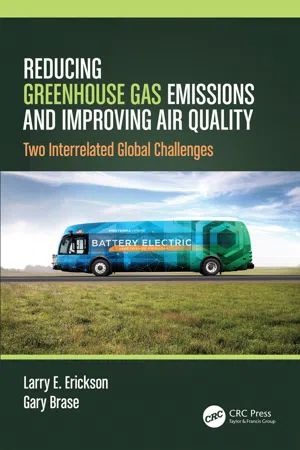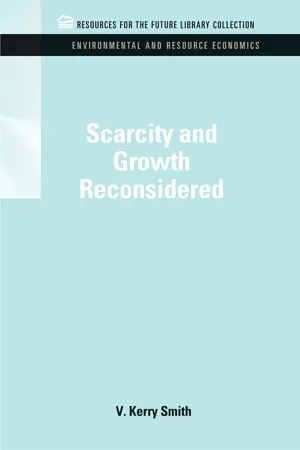Economics
Common Resources
Common resources are goods or services that are non-excludable but rivalrous, meaning they are available to all but can be depleted by use. Examples include fisheries, forests, and clean air. Common resources often face the challenge of overuse or depletion due to the difficulty in regulating access and usage, leading to the "tragedy of the commons" dilemma.
Written by Perlego with AI-assistance
Related key terms
4 Key excerpts on "Common Resources"
- eBook - ePub
Reducing Greenhouse Gas Emissions and Improving Air Quality
Two Interrelated Global Challenges
- Larry E. Erickson, Gary Brase(Authors)
- 2019(Publication Date)
- CRC Press(Publisher)
A major difficulty with Common Resources is that people are chronically tempted to take more than their fair share of the fringe units for their own use, even though doing so damages the Common Resources overall (Parks, et al., 2013). This can be tempting because resources taken for one’s own use are entirely for one’s own benefit, but the damage to the common resource overall is spread out over all the possible users of the resource. A short-term calculation of costs and benefits, therefore, can lead people to overuse the common resource – a phenomenon known as the “tragedy of the commons” (Hardin, 1968).What happens when Common Resources get severely overused, with little or no effective management? One possibility is the complete collapse and destruction of the commons (e.g. overfishing leads to the extinction of the fish, or at least a reduction of the core stock to a point that use of the common resource is no longer possible). Another possibility to address a depleted common resource is to intervene by placing limits on users – circumspecting where, when, or how much of the resource can be taken. For instance, limits can be put on how many fish one person can catch, how many trees can be felled in a forest, or how much water can be taken from a river. This changes a common resource into a club good , which means (in economic terms) that the resource is now excludable (i.e. access is limited) and potentially non-rivalrous (i.e. rules specify how everyone can partake in the resource). There are also club goods that do not derive from renewable resources (e.g. country club memberships, cable television, and toll roads), but these are not the focus here.Yet another possibility, and of more interest in the present context, is that some users intervene with contributions that allow the resource to be maintained. The situation is, at this point, no longer just a common pool resource but rather a public good - eBook - ePub
Environmental and Natural Resource Economics
A Contemporary Approach
- Jonathan M. Harris, Brian Roach(Authors)
- 2021(Publication Date)
- Routledge(Publisher)
For example, in Scotland, trout-fishing rights on certain rivers are jealously guarded property. But it is difficult to parcel up every function of the river and define it as someone’s property. To some degree, the river is a common property resource —it is accessible to everyone and not subject to private ownership. Technically speaking, a common property resource is one that is nonexcludable because people cannot easily be excluded from using it. The other characteristic of a common property resource is that it is rival, meaning that its use by one person diminishes the quantity or quality of the resource available to others. common property resource a resource that is available to everyone (nonexcludable), but use of the resource may diminish the quantity or quality available to others (rival). nonexcludable a good that is available to all users, under conditions in which it is impossible, or at least difficult, to exclude potential users. rival a good whose use by one person diminishes the quantity or quality of the good available to others. Consider groundwater as an example of a common property resource. Anyone can access groundwater by drilling a well; thus, it is nonexcludable. But groundwater is rival because each user depletes the aquifer somewhat, leaving less water available to other potential users. How can a common property resource be managed to maximize social benefits? Is government regulation required to prevent the overuse of the resource, and, if so, what types of regulations can be effective? We address these questions using the example of an ocean fishery. The Economics of a Fishery A classic example of a common property resource is an ocean fishery. While inland and coastal fisheries are often governed by private, traditional, or government management systems, fisheries in the open ocean are typically open-access resources. An open-access resource is a common property resource that lacks any system of rules governing its use - eBook - ePub
- Ana Espinola-Arredondo, Felix Munoz-Garcia, Richard A Matthew, Connor Harron, Kristen Goodrich, Bemmy Maharramli;Evgenia Nizkorodov;Tony Bryant;Anabela Botelho(Authors)
- 2016(Publication Date)
- WSPC(Publisher)
CHAPTER 2
Common Property Resource Exploitation under Imperfect Competition
Hassan Benchekroun
Department of Economics, CIREQ, McGill University855 Sherbrooke Ouest, Montreal, QC H3A-2T7, Canada[email protected]This chapter reviews recent developments in the literature on the exploitation of a renewable resource by an oligopoly. We review how to successfully design more conservative unilateral policies that aim to increase the common resource stock. We show how increasing the reproduction rate of the resource, for example through research and development policies may be counterproductive and exacerbate the tragedy of the common. We discuss the specificity of antitrust and competition policy in the context of a resource oligopoly: there could be larger incentives to merge or collude than in a standard Cournot oligopoly setup. Antitrust authorities must therefore be more vigilant in the case of resource industries. Other policy implications such as the design of property rights or free trade are also reviewed.2.1INTRODUCTION
The literature on the economics of common pool resources is vast. It often covers the exploitation of essential assets for communities, regions or countries. These assets include fisheries, water (aquifers and irrigation systems), land, forestry, clean air, etc.The relevance of the study of common pool resources is due to the fact that they are not only essential but they are also fragile given that they are managed under common property. Although there are several documented cases where common pool resources have been successfully managed by a community (e.g., Ostrom, 1990), it is by no means the rule. Under the assumption that agents exploiting the resource are utility maximizers and in the absence of altruism, exploitation of a resource under common property and open access leads to the tragedy of the commons. Several economic policies have been examined in the literature, however, one that seems a first step in any intervention is to limit access to the resource. - eBook - ePub
- V. Kerry Smith(Author)
- 2013(Publication Date)
- RFF Press(Publisher)
Thus far we have discussed the assumptions and potential theoretical limitations of these models on their own terms. That is, we have accepted implicitly the narrow definition of natural resources as those goods which exchange on primary commodity markets. Once the definition is expanded to be consistent with the definition we stated at the outset, a reexamination of the conclusion of the model and the associated policy implications is further justified.There are two problems raised by ignoring the role of the nonpriced services of common property resources in neoclassical models involving natural resources. Quite aside from the inability of such limited formulations to portray all aspects of behavior, this partial view of the character of natural resources can introduce both theoretical and empirical biases in the results. Consider the analysis of a mining firm. Improvements in the state of the art governing the firm's ability to extract larger quantities of a constant quality ore or to tap lower grade deposits may be made at the expense of greater use of the services of common property resources. One of the methods used in measuring the effects of technical change in production processes calls for allocating the gains in productivity to all measured inputs for the process involved. Since the services of common property resources do not exchange on organized markets, they are omitted in these methods and thus such an evaluation contains theoretical biases associated with the underlying model as well as biased empirical analyses of the determinants of reductions in unit extraction costs. While one might call for the use of shadow prices in making such calculations, this will not change the fact that the market transactions do not reflect the use of the services of common property resources as components of the full extraction costs.For the aggregate models, the difficulties introduced with the expanded definitions are equally striking. Omitting consideration of the services of common property resources as a type of natural resource input implicitly assumes either that: (1) these services make no contribution to the production of measured outputs, or (2) these services can be estimated from the levels of raw material inputs by assuming their use levels are proportional to those of the materials.
Learn about this page
Index pages curate the most relevant extracts from our library of academic textbooks. They’ve been created using an in-house natural language model (NLM), each adding context and meaning to key research topics.



